
Laszlo Schwed
Born: 1904
Kiskunfelegyhaza, Hungary
Laszlo was raised by Hungarian-speaking Jewish parents in the town of Kiskunfelegyhaza in southeastern Hungary. He opened a business selling goose meat, feathers, down and quilts. In 1931 he married Anna Mahrer, from Budapest, and they had a daughter in January 1932.
1933-39: Laszlo and Anna had a second child, a son. They raised their two children in a comfortable home. Kiskunfelegyhaza was located in a rural part of Hungary. In May 1939, the Hungarian government enacted a law that defined Jews as alien people and limited their employment in Hungarian businesses. As a result, Lazlo was forced to fire some of his Jewish employees.
1940-44: In November 1940 Hungary became an ally of Nazi Germany. More laws were enacted to restrict the rights of Hungary's Jews. In April 1944, less than a month after the Germans occupied Hungary in March, Jews were ordered to wear an identifying yellow star on their clothing. Kiskunfelegyhaza's 700 Jews were moved into a ghetto set up by Hungarian officials. Two months later, all 700 were transported to Kecskemet, a deportation center for Jews in south-central Hungary.
Between June 25 and 28, 1944, Laszlo and his family were deported to Auschwitz, where they perished. Laszlo was 40 years old.